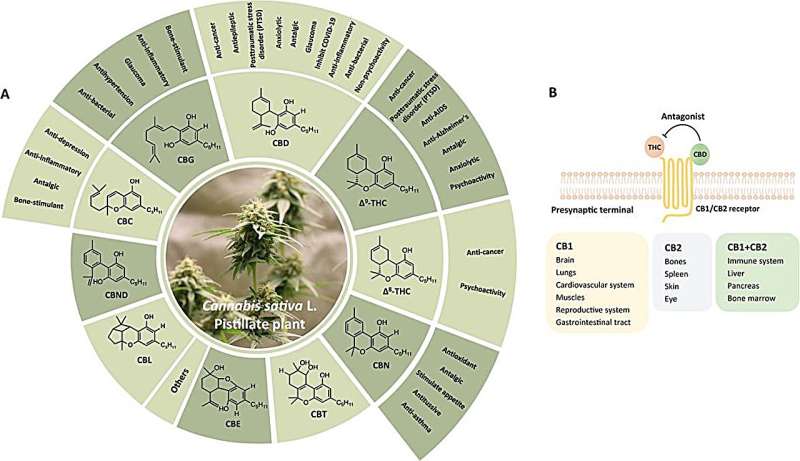This article has been reviewed according to Science X's editorial process and policies. Editors have highlighted the following attributes while ensuring the content's credibility:
fact-checked
peer-reviewed publication
proofread
Cannabis sativa: Historical significance, genetic insights, and future potential in medicine and horticulture

Cannabis sativa, historically valued for its diverse uses in food, fiber, and medicine, is facing a shift in global perspective. Cannabinoids are the most abundant in Cannabis. Among them, the psychoactive cannabinoid ∆9-tetrahydrocannabinol (∆9-THC) has addictive properties but is efficacious as medicine.
Recently, cannabidiol (CBD), a non-psychoactive cannabinoid, has been clinically validated to treat specific medical conditions. Despite remarkable advancements in the cultivation of Cannabis plants with high-yielding cannabinoids and the reconstruction of cannabinoid production, challenges remain in understanding the genetic and biochemical mechanisms of cannabinoid biosynthesis.
In July 2023, Horticulture Research published a review article titled "Cannabis sativa: origin and history, glandular trichome development, and cannabinoid biosynthesis." In this article, researchers comprehensively review the historical usage of Cannabis, biosynthesis of trichome-specific cannabinoids, regulatory network of trichome development, and synthetic biology of cannabinoids.
Cannabis has a long history of human use. The medicinal use of Cannabis was first documented in "Shen Nong Ben Cao Jing," and there are also records in the history of Egypt, India and France. Originally, Cannabis was primarily cultivated to obtain seeds and fiber.
Before 1260 BCE, there were records of the spiritual use of Cannabis smoke. Its psychoactive properties, primarily due to THC, have led to varying global legal restrictions, though recent liberalization in some regions acknowledges its economic and pharmacological benefits.
The debate over its origin suggests Central Asia or the northeastern Tibetan Plateau as potential centers, with recent studies indicating a likely domestication in East Asia.
Cannabinoids, the main compounds in Cannabis, include over 130 identified types, of which THC and CBD are the most significant. These cannabinoids interact with the human endocannabinoid system, influencing functions like sleep, appetite, and mood.
Recent research reveals the therapeutic properties of various cannabinoids, including anti-inflammatory and antitumor effects, though challenges remain in extracting some of the lesser-known cannabinoids. The review also points out the biosynthesis, trafficking, and secretion of cannabinoids in the Cannabis glandular trichomes (GTs), with recent discoveries elucidating the two main biosynthetic pathways. However, understanding the genetic basis of THC and CBD synthesis remains complex, necessitating further research for comprehensive insights.
The manipulation of external environmental factors and genetic transformation are key areas for increasing desirable cannabinoid content like CBD and decreasing the content of THC, though the development of an efficient transformation system in Cannabis poses challenges.
The researchers also summarized the transcriptional regulatory network of GTs development in Artemisia annua and Solanum lycopersicum, in order to provide reference for the regulation of GTs in cannabis. Advances in metabolic engineering offer promising avenues for cannabinoid production.
Techniques like introducing specific genes into microbial hosts have shown potential in synthesizing cannabinoids like THC and CBD, though achieving high yields remains a challenge. The application of cell-free systems has shown substantial improvements in cannabinoid production, surpassing results using living cells.
The review concludes by emphasizing the need for innovative research in understanding cannabinoid biosynthesis and secretory GTs development.
Advancements in sequencing technologies and multi-omics approaches are crucial for selecting candidate genes and unraveling regulatory mechanisms. Additionally, efficient green bioproduction of cannabinoids and the development of novel Cannabis varieties with desirable traits are vital for meeting the increasing global demand for cannabinoids.
Overall, this comprehensive exploration of Cannabis underscores its significant impact on human health and the potential for future transformative applications.
More information: Ziyan Xie et al, Cannabis sativa: origin and history, glandular trichome development, and cannabinoid biosynthesis, Horticulture Research (2023). DOI: 10.1093/hr/uhad150
Journal information: Horticulture Research
Provided by TranSpread



















